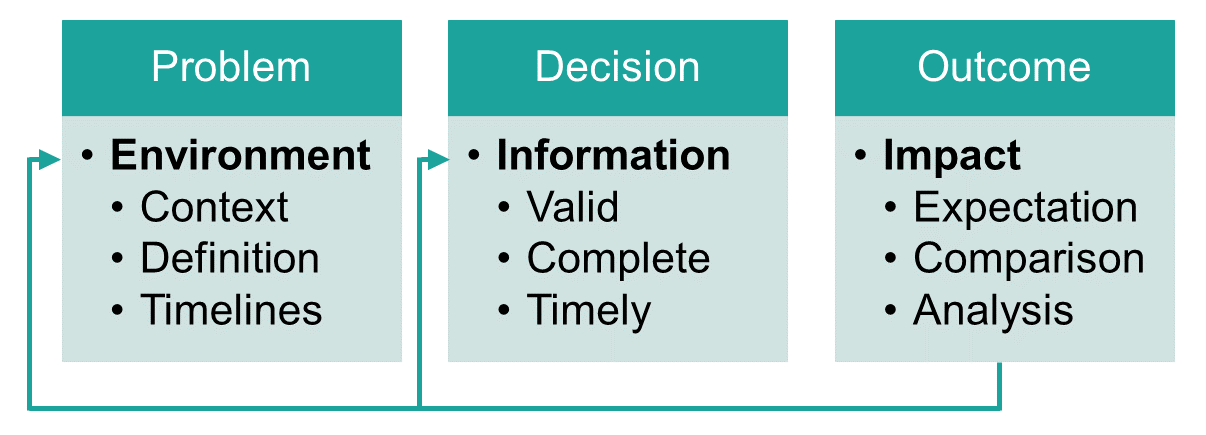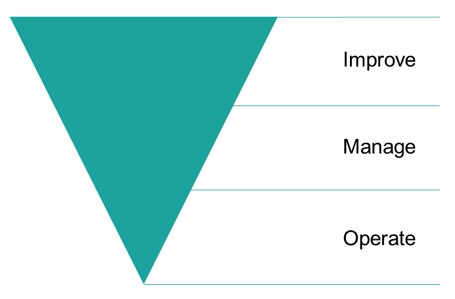How can we use data to improve decision-making?
A guide to strategic, operational and analytical decision-making in business.
This guide to data-driven decision-making comes with insights from professionals in the software, emergency services, charity and marketing spaces. They kindly lent their time to a discussion in April 2023 as part of our roundtable series at CDS headquarters in Leeds. Attendees looked at the role of informed decision-making and how to improve it with data.
Our guide offers actionable tips for all stakeholders to identify what kinds of decisions they’re making, discover added value in their data and use models to drive business change.
Executive summary
In modern business, data is currency. While we can access more data than ever, it is not enough in isolation. We need to add our expertise to make decisions, impacting both short-term processes and long-term strategic change.
Our qualitative, ‘human’ insights help us extract value from data. But so too do the right decision-making models, including a problem, decision and outcome-based approach. When combined with a diverse set of contributors and the right measurement tools, these models help us to improve processes, cut costs and sharpen the user experience.
What is data-driven decision-making?
Decisions are processes, for example:
- Operational decisions: short-term decisions that affect the day-to-day, such as how to manage time and resources.
- Strategic decisions: longer-term decisions that impact the overall vision of the business, such as developing profitable products.
- Analytical decisions: evidence-based decisions to solve problems that might have more than one right answer, looking at cause and effect.
The outcomes of the decisions we make are driven by insights. We use our own expertise and experience to inform them. But this process alone is not enough.
Insights are only as powerful as the data they have to back them up. We can categorise data, and more importantly, gain value from it, by putting it into context. We might look at the problem and the outcomes of different options, as well as the environment itself.
Roundtable participant
How to make data-driven decisions
Not all decisions are equal. Many ‘big’ decisions are actually made up of many smaller ones. For best results, we also need to focus on three key things: the environment, the information, and the impact.
The flow looks like this:

The problem
We cannot solve a problem if we don’t understand it. This involves looking at our environment and the context of the problem – its impacts and the timescales involved. We need to decide how much time is required to solve the issue, which is a key difference between operational and strategic decisions.
The decision
The information we have to guide decision-making needs to be valid, complete, and timely and include evidence-based insights or “qualitative” data, as well as quantitative data. This information should also be comprehensive – including facts and figures from a full timeline to be representative.
It must also be up-to-date. We cannot make decisions for the here and now if the data is no longer relevant – for example, launching a new product based on the historical success of a now obsolete one.
The outcome
The outcome looks at the impact of the decision – what we expected to happen versus what actually happened. We can then analyse this outcome and make future decisions based on what went right and what went wrong. We might have relied too much on quantitative data, for example, rather than insight.
Roundtable participant
Identifying the value of data through data insights
To get the best results from our decisions, we have to look for the value in the data we have. Judith Doherty, who co-hosted this roundtable event, says:
Judith Doherty
Insight account director, CDS
Data can be a mixture of both. The real value comes from what we do with it, which starts with recognising what we can achieve.
What is the value of data?
Roundtable participants agreed that data objectively informs everything we do in business, from identifying gaps in operations to finding new audiences.
Operate
Data helps us to optimise operations by running key processes. For example, we can run gap analyses to spot missing opportunities and create new content to attract warm leads.
We can also use data to inform systems such as machine learning to make forecasts. These even help to avoid risk – for instance, supply and demand planning.
Make decisions
Data can empower us to make operational, strategic and analytical decisions.

Roundtable participant
Again, this is where insights and data converge – these quantitative figures help us decide the what, how and when of our operations.
Improve
Participants shared examples of how data has helped to automate, prioritise, disseminate, predict and understand every facet of their business.
Roundtable participant
It can even tap into our emotions, particularly when we consider theories like Maslow’s Hierarchy of Needs. This is why it’s crucial not to discount humans altogether. Machine learning is getting better all the time, when it comes to gathering and interpreting data, but only our empirical experience can help us use this data to its full potential.

Roundtable participant
How do we identify where the value is?
We know what data can help us do, but how do we find this value in the first place? Our three-pronged approach involves analysing:
1. Risk
These are the hypotheticals. We reverse-engineer these by picturing what would happen if we didn’t have the data, or if it was incorrect. For example, would we waste thousands of pounds over-ordering stock if we had the incorrect forecasting data?
2. Reusability
We can make the same data work harder by using the same information for different outcomes. Let’s say we have a vast set of user activity metrics on an e-commerce site. We could use this to inform not only page design, but the best time of day to push products for sale.
3. Improvement
This is a blend of hypotheticals and reality. We might know something, but what if we knew something else? For example, we might know that X number of users are leaving a certain web page, but what if we had qualitative feedback to find out why?
There is no danger in starting small. In fact, many organisations fail by trying to take on too much. Instead, progress needs to be incremental – smaller, sustainable changes that drive an ultimate cultural shift.
Roundtable participant
How do we increase the value of data?
Making the case for investment in data comes from recognising its value. We can only make it valuable by measuring and validating it, for example:
- Use conceptual modelling: a representation of our current processes or people helps us to simulate all scenarios, looking at best practices and ideal outcomes. This aids the setting of expectations for different areas of the business so we can understand how they interact with each other. For example, how are sales and marketing teams interacting, and are they missing opportunities to collaborate?
- Check data quality: as discussed, anything we’re using to make a decision should be complete, accurate and timely. If it’s a vanity metric then it will have no impact on strategic or operational outcomes.
- Combine different data sources: we need to hear from various stakeholders to get a complete picture of the organisation’s goals. There may be information being held in silos, or certain departments may feel undervalued. We shouldn’t discount customers, either – user feedback helps us understand not just how our customers interact, but why.
Geoff Barraclough
Director of Data Services, CDS
How a data maturity model can help improve business decision-making
Whichever stage your business is at, there is room for progress around data-driven decision-making. A data maturity assessment is a great place to start, studying how well your data is working for you and what value you can gain from it.
From a long-term perspective, we can make progress with data-driven decision-making by:
- Starting small: look for incremental gains informed by the most basic of metrics. Some data is better than none at all, but make sure this is high-quality and complete so that it can be understood.
- Measuring impacts: only use information you can measure to make decisions. This will help to benchmark performance and support your business case for future changes.
- Find advocates: you need support to make your decisions. Use evidence to back up your case and start with several smaller projects that will result in more significant improvements. This includes user research – remember to take people with you and move at a pace that is relevant to them.
Conclusion
Each decision we make has operational, strategic or analytical outcomes. These may be significant cultural changes or comparatively minor adjustments to simple day-to-day processes.
When making decisions, it’s important to combine both numerical data and human insight. Often, this needs first-hand experience and even emotional input.
To make data-led decisions, we need to follow the problem, decision and outcome model. This helps us contextualise the issue and use a complete set of accurate data to overcome it. We can then measure our performance and use this for future business cases.
Advancements in machine learning and artificial intelligence help us gather and apply information, but we still need our own insights. This is where we learn to take a value-led approach to data – using it to run operations, make decisions and improve processes.
We can encourage this value-led approach by looking at risk, reusability and improvement. A risk-based model takes us back to basics and asks how we can solve the biggest problems. Reusability helps us use the same figures to make multiple decisions. Improvement acknowledges that we may have some insights – but also recognises where we could go further, to keep moving forward.
To progress, we must have an open, collaborative and transparent approach, valuing every stakeholder in the organisation. From giving a voice to siloed departments to uncovering user feedback, every bit of data is relevant if we use it to its full potential.
Our roundtable guests have demonstrated this in their real-life examples, from hiring staff to reaching new markets. We should harness technology and human input to gain maximum value from data long-term.
How can CDS help?
- Data quality and access
- Planning and benchmarking
- User research
- Customer and user experience research
- Inclusivity and accessibility audit
- Service, ecosystem, and landscape mapping
- User experience baseline review
- Business analysis (operating model)

Get in touch
Keen to find out more about how we can help you navigate a successful digital change? Let’s talk.